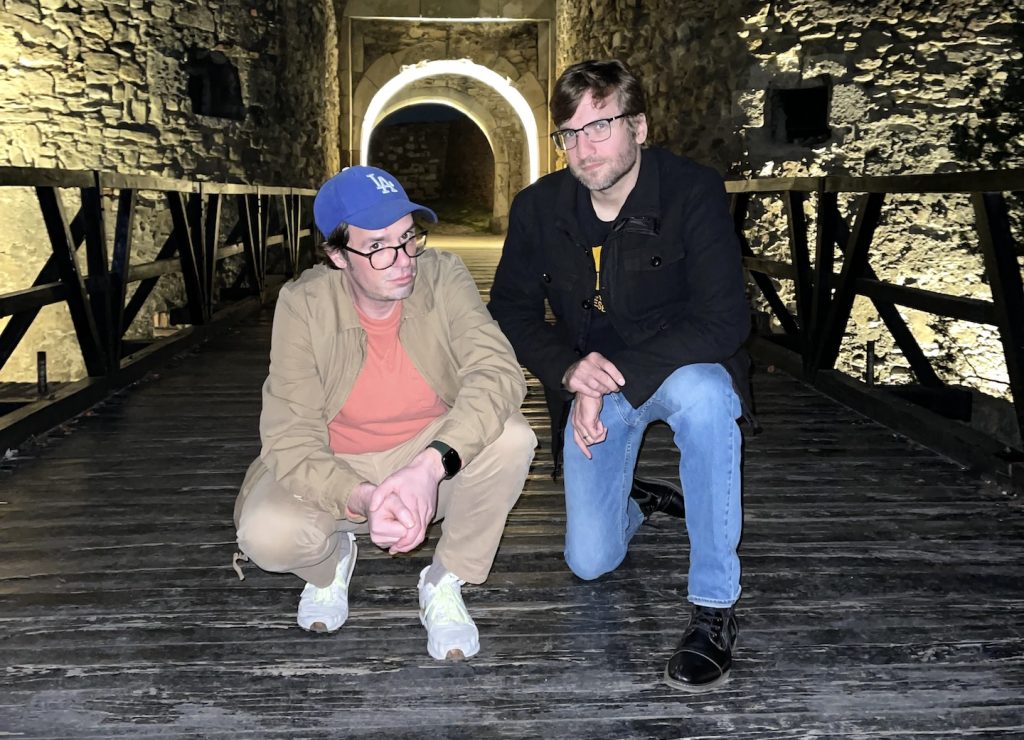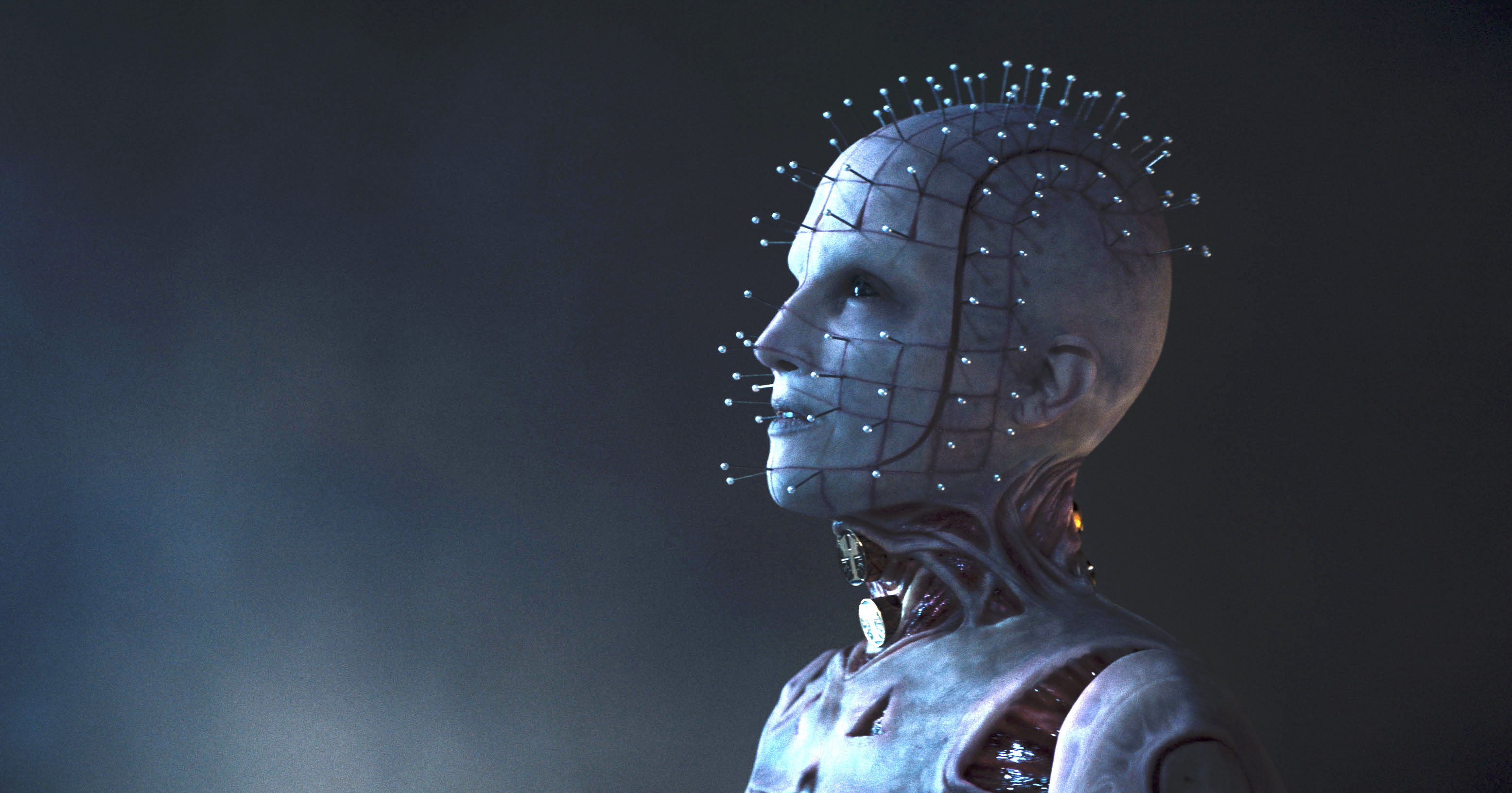In 1987, Clive Barker adapted his novella Hellhound Heart into a horror film called Hellraiser. There have been numerous sequels to it which lead to the 2022 version by Ben Collins and Luke Piotrowski (The Night House, Stephanie). Hellraiser was a curious combination of critical, commercial and cult classic.
“To me the movie has always had a thick air of mystery to it that draws people in,” said Collins. “When you watch it, you don’t necessarily get any more answers,” he continued. Hellraiser contains many iconic images especially Lead Cenobite (Pinhead) as initially portrayed by Doug Bradley. True to Clive Barker’s intention, the Coenobites represent both the extreme pleasure and pain that we summon.
“Hellraiser is a movie that you remember images from bit maybe can’t piece them together,” Ben continued. This aspect of the film franchise makes it stand out from other horror films from the 80s, which were much clearer with their themes and intentions.
We pitched Hellraiser as three things – Sex, Death, and Puzzles – Luke Piotrowski
Piotrowski contends that if you remove one of these elements, Hellraiser becomes something else. “If it’s death and puzzles it becomes Saw. If it’s just sex and death it becomes a lot of other horror movies,” he added. “Hellraiser has an esoteric and transgressive quality that combines the sexual energy with the grotesque.” He believes that this magic invites repeated viewings. Clive Barker refers to it as “repulsive glamour.”

Ben Collins & Luke Piotrowski
Ben and Luke were not officially attached to Hellraiser for many years. “We were actively pursuing it since around 2012 with Dimension Films and engaged with three or four iterations of the project for many years,” recalled Ben.
Hellraiser comes with its own set of unique legal encumbrances because several people around town claim to own or have access to the various rights to the franchise. “We dealt with different iterations ranging from sexless teenagers to PG-13 more investigatory slasher films,” said Ben. “We maintained the integrity of Hellraiser to allow it to be what it was.” Some iterations were so far removed from the film’s original intention, the writers immediately rejected them. “For some people, Hellraiser is the poetry of horror, for others it’s more it’s about the splatter,” said Luke.
The version of Hellraiser 2022 was based on a treatment by David S. Goyer (The Sandman, Foundation). This freed up Collins and Piotrowski creatively after the basic concept was decided. “There were core tenets in Goyer’s ten-page treatment and we could build on those ideas,” continued Collins. “We could add our interests on t0p of that basic structure.”
The writing duo were delighted with Goyer’s treatment because it overlapped with many of their ideas. There was a shared vision of what Hellraiser 2022 could be. “It was the first treatment we received that felt useful and didn’t conflict with somebody else’s intention for the property,” said Collins. Producer Keith Levine and director David Bruckner both worked on The Night House with Collins and Piotrowski were also attached to Hellraiser. As it happens, David S. Goyer was also a producer on this project.
The thematic thrust of Goyer’s treatment was dealing with grief following the loss of a sibling. “This lead to the interaction with the puzzle box and the entry into the world,” said Collins. Team Ben and Luke had just finished The Night House which also dealt with grief, so they felt they had to do something different thematically. “So, ours became a story about addiction. We used Goyer’s structure to explore a different thematic space,” said Ben.
The fusion of Goyer’s and Ben and Luke’s ideas recognized the need “for a more explored set of rules for the Cenobites and box mythology,” mused Piotrowski. The writers felt that the various sequels of Hellraiser didn’t succeed as well as they should have because there was a lack of consistency in the rules. “We wanted to get the mythology back on its feet,” declared Ben.
Neither Goyer, Piotrowski or Collins had a clear vision of the Cenobites’ world which was only galvanized when director David Bruckner came on board. “There was a magical coalescing of visions,” recalled Ben.
B-Grade Horror
Ben Collins and Luke Piotrowski are acutely aware that the Hellraiser franchise has ten movies in under its belt – many of them consigned to B-movie status. Some see it as a criticism, but Collins and Piotrowski revel in it.
“I’ve always been a fan of B-grade horror movies and trashy entertainment. I’ve also studied literature, so I have this appreciation for Shakespeare and monsters,” said Ben.
“One of the joys of being a screenwriter is that I have the chance to play with other people’s toys. I looked at the Hellraiser franchise and found out what makes it tick and how we can make it different.” The writing pair lamented that as the franchise continued, it leant more into the grotesque and disgusting aspects of the story. “They essentially became serial killer films,” continued Ben. “The canon of the franchise was broken as it moved from theatrical to straight to DVD,” lamented Luke. It is also an open secret that many previous Hellraiser scripts were written as other movies and reconfigured to fit a Hellraiser mould. “The franchise finally went back on track in Hellraiser: Judgement in 2018,” he added. Sadly, many of the sequels were made by people who considered themselves to be fans, but controlled by corporate overlords.
Long-established franchises come with long-established iconography that remain in your head since childhood. “I love the idea of sequels, especially Hellraiser,” exclaimed Luke. “We were intoxicated by our belief that we could represent something with awe and a sublime quality,” he continued.

Clive Barker
Ben and Luke set out to make a ‘requel ‘ of the original Hellraiser that respected the original, but also allowed them to express their creative flair. “It’s designed to work for both new and established audiences,” said Luke. They worked hard to honor everything that came before it, despite its sometimes contradictory or illogical nature. One thing that was completely reimagined was the design of the box and the Cenobites. Pinhead was too iconic a character to be tinkered with. So long as the underlying themes of pleasure and pain were maintained, they were on solid footing.
A Baroque Cosmic Style
Ben describes the style of Hellraiser as baroque – ornate and stylish. It contains grandeur, sensuousness, drama, richness, dynamism, movement, tension, emotional exuberance and a tendency to blur the boundaries between art. “The baroque style leans into the foreboding, ominous beauty that the world offers,” he continued.
“There’s a little bit of cosmic horror in there such as Lovecraft,” added Luke. “You can’t visualise it. You’re interacting with something otherworldly and powerful.”
The writers also see the need for carefully-measured jump scares. “The tension, expectation and sense you’re in the presence of something godlike is also there,” said Luke.
In an era of elevated horror, the term B-grade horror has negative associations. “Elevated horror is a quality determination,” said Ben. “Everything else is considered a lesser artistry.” The writers concede that B-grade is a genre of horror rather than a slight. “It has a different emphasis, intent, and themes, but it isn’t a lesser art form,” said Ben. “It’s a different type of entertainment.”
Lower production value doesn’t equate to poor storytelling. “You need to have characters you can take seriously that you care about,” said Ben.
Clive Barker, the creator of Hellraiser, has a sense of prestige and sophistication to his work. However, if it becomes a splatterfest at the expense of an identifiable theme or characters, it can become a lesser art form.
“Hellraiser has characters that are difficult people,” Luke added. “Monsters are people too. Their actions come from difficult life experiences and observations,” said Ben. “A lot of this relates to underlying trauma. They come from an intense emotional place.”
Luke described his trademark writing signature in his work as “having sympathy for the monsters.” The main character may either be the monster or the hero may act in monstrous ways. So too are the Cenobites. “There seems to be a struggle to understand the antagonistic forms in many horror films.“
